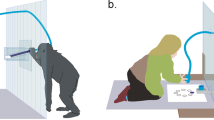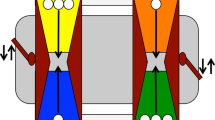Abstract
Common-pool resource (CPR) dilemmas are pervasive challenges to overcome. We presented six-year-old children with an experimental CPR paradigm involving a renewable water resource, which children could collect to win individual rewards. To maximize water collection, children had to wait for water to accumulate, without collapsing the resource. We explore the social strategies children used to overcome the dilemma together. Like adults, six-year-old children were challenged by the dilemma: resource sustaining was more successful in a parallel condition in which children worked independently compared with the collective CPR condition. However, children were capable of collectively preventing resource collapse by spontaneously generating inclusive rules, equally distributing the rewards and distracting one another from the delay-of-gratification task. Children also learned to sustain the resource longer in repeated interactions with the same partner. Already by the age of six, children are capable of CPR social strategies resembling those of adults.
This is a preview of subscription content, access via your institution
Access options
Access Nature and 54 other Nature Portfolio journals
Get Nature+, our best-value online-access subscription
$29.99 / 30 days
cancel any time
Subscribe to this journal
Receive 12 digital issues and online access to articles
$119.00 per year
only $9.92 per issue
Buy this article
- Purchase on Springer Link
- Instant access to full article PDF
Prices may be subject to local taxes which are calculated during checkout






Similar content being viewed by others
Change history
21 June 2018
In the version of this Article originally published, two notes reading ‘[CJ1]’ and ‘[CJ1]This should stay the same. It does refer to a particular seminal experiment and is also not the subject of the citation (40) which refers to a review article’ were mistakenly left in the seventh paragraph of the text. These notes have now been removed.
References
Ostrom, E., Gardner, R. & Walker, J. Rules, Games, and Common-Pool Resources (Univ. Michigan Press, Ann Arbor, MI, 1994).
Hardin, G. The tragedy of the commons. Science 162, 1243–1248 (1968).
Tomasello, M. Why We Cooperate (MIT Press, Cambridge, MA, 2009).
Acheson, J. M. The Lobster Gangs of Maine (Upne, Lebanon, NH, 1988).
Anderson, L. R., Mellor, J. M. & Milyo, J. Inequality and public good provision: an experimental analysis. J. Socio-Econ. 37, 1010–1028 (2008).
Tavoni, A., Dannenberg, A., Kallis, G. & Löschel, A. Inequality, communication, and the avoidance of disastrous climate change in a public goods game. Proc. Natl Acad. Sci. USA 108, 11825–11829 (2011).
Ostrom, E. The value-added of laboratory experiments for the study of institutions and common-pool resources. J. Econ. Behav. Organ. 61, 149–163 (2006).
Hackett, S., Schlager, E. & Walker, J. The role of communication in resolving commons dilemmas: experimental evidence with heterogeneous appropriators. J. Environ. Econ. Manag. 27, 99–126 (1994).
Schmitt, P., Swope, K. & Walker, J. Collective action with incomplete commitment: experimental evidence. S. Econom. J. 66, 829–854 (2000).
Janssen, M. A. Introducing ecological dynamics into common-pool resource experiments. Ecol. Soc. 15, 8 (2010).
Biel, A. & Thøgersen, J. Activation of social norms in social dilemmas: a review of the evidence and reflections on the implications for environmental behaviour. J. Econ. Psychol. 28, 93–112 (2007).
Orbell, J. M., Van de Kragt, A. J. & Dawes, R. M. Explaining discussion-induced cooperation. J. Pers. Soc. Psychol. 54, 811–819 (1988).
Richerson, P. & Henrich, J. Tribal social instincts and the cultural evolution of institutions to solve collective action problems. Cliodynamics 3, 38–80 (2009).
Dawes, R. M., McTavish, J. & Shaklee, H. Behavior, communication, and assumptions about other people’s behavior in a commons dilemma situation. J. Pers. Soc. Psychol. 35, 1–11 (1977).
Dawes, R. M., Orbell, J. M., Simmons, R. T. & Van De Kragt, A. J. Organizing groups for collective action. Am. Political Sci. Rev. 80, 1171–1185 (1986).
Croson, R. T. Theories of commitment, altruism and reciprocity: evidence from linear public goods games. Econ. Inq. 45, 199–216 (2007).
Goldstein, N. J., Cialdini, R. B. & Griskevicius, V. A room with a viewpoint: using social norms to motivate environmental conservation in hotels. J. Consum. Res. 35, 472–482 (2008).
Kazemi, A. & Eek, D. in New Issues and Paradigms in Research on Social Dilemmas (eds Biel A., Eek, D., Gärling T. & Gustafsson, M.) 72–92 (Springer, Boston, MA, 2008).
Colding, J. & Folke, C. Social taboos: “invisible” systems of local resource management and biological conservation. Ecol. Appl. 11, 584–600 (2001).
Cardenas, J.-C. & Carpenter, J. Behavioural development economics: lessons from field labs in the developing world. J. Dev. Stud. 44, 311–338 (2008).
Kerr, N. L. in Social Dilemmas: Social Psychological Perspectives (ed. Schroeder, D.) 31–47 (Pergamon Press, New York, NY, 1995).
Agrawal, A. Common property institutions and sustainable governance of resources. World Dev. 29, 1649–1672 (2001).
Gummerum, M., Hanoch, Y. & Keller, M. When child development meets economic game theory: an interdisciplinary approach to investigating social development. Hum. Dev. 51, 235–261 (2008).
Wellman, H. M., Cross, D. & Watson, J. Meta‐analysis of theory‐of‐mind development: the truth about false belief. Child Dev. 72, 655–684 (2001).
Sally, D. & Hill, E. The development of interpersonal strategy: autism, theory-of-mind, cooperation and fairness. J. Econ. Psychol. 27, 73–97 (2006).
Takagishi, H., Kameshima, S., Schug, J., Koizumi, M. & Yamagishi, T. Theory of mind enhances preference for fairness. J. Exp. Child Psychol. 105, 130–137 (2010).
Feinfield, K. A., Lee, P. P., Flavell, E. R., Green, F. L. & Flavell, J. H. Young children’s understanding of intention. Cogn. Dev. 14, 463–486 (1999).
Call, J. & Tomasello, M. Distinguishing intentional from accidental actions in orangutans (Pongo pygmaeus), chimpanzees (Pan troglodytes) and human children (Homo sapiens). J. Comp. Psychol. 112, 192–206 (1998).
Sodian, B., Taylor, C., Harris, O. L. & Perner, J. Early deception and the child’s theory of mind: false trails and genuine markers. Child Dev. 62, 468–483 (1991).
Grueneisen, S., Wyman, E. & Tomasello, M. Conforming to coordinate: children use majority information for peer coordination. Br. J. Dev. Psychol. 33, 136–147 (2015).
Grueneisen, S., Wyman, E. & Tomasello, M. “I know you don’t know I know…” Children use second‐order false‐belief reasoning for peer coordination. Child Dev. 86, 287–293 (2015).
Sloane, S., Baillargeon, R. & Premack, D. Do infants have a sense of fairness? Psychol. Sci. 23, 196–204 (2012).
Blake, P. R., McAuliffe, K. & Warneken, F. The developmental origins of fairness: the knowledge–behavior gap. Trends Cogn. Sci. 18, 559–561 (2014).
Grueneisen, S. & Tomasello, M. Children coordinate in a recurrent social dilemma by taking turns and along dominance asymmetries. Dev. Psychol. 53, 265–273 (2017).
Vogelsang, M., Jensen, K., Kirschner, S., Tennie, C. & Tomasello, M. Preschoolers are sensitive to free riding in a public goods game. Front. Psychol. 5, 729 (2014).
Harbaugh, W. T. & Krause, K. Children’s altruism in public good and dictator experiments. Econ. Inq. 38, 95–109 (2000).
Camerer, C. Behavioral Game Theory (New Age International, New Delhi, 2010).
House, B., Henrich, J., Sarnecka, B. & Silk, J. B. The development of contingent reciprocity in children. Evol. Hum. Behav. 34, 86–93 (2013).
Sanchez-Amaro, A., Duguid, S., Call, J. & Tomasello, M. Strategic decision-making by chimpanzees (Pan troglodytes), bonobos (Pan paniscus) and children in a snowdrift-game task. Preprint at https://doi.org/10.7287/peerj.preprints.1805v1 (2016).
Kortenkamp, K. V. & Moore, C. F. Time, uncertainty, and individual differences in decisions to cooperate in resource dilemmas. Pers. Soc. Psychol. Bull. 32, 603–615 (2006).
Mischel, W., Shoda, Y. & Rodriguez, M. L. Delay of gratification in children. Science 244, 933–938 (1989).
Mischel, W. & Ebbesen, E. B. Attention in delay of gratification. J. Pers. Soc. Psychol. 16, 329–337 (1970).
Yates, G. C., Yates, S. M. & Beasley, C. J. Young children’s knowledge of strategies in delay of gratification. Merrill Palmer Q. 33, 159–169 (1987).
McCabe, L. A. & Brooks-Gunn, J. With a little help from my friends?: Self-regulation in groups of young children. Infant Ment. Health J. 28, 584–605 (2007).
Nisan, M. Delay of gratification in children: personal versus group choices. Child Dev. 47, 195–200 (1976).
Dawes, R. M., Ven De Kragt, A. J. & Orbell, J. M. Not me or thee but we: the importance of group identity in eliciting cooperation in dilemma situations: experimental manipulations. Acta Psychol. 68, 83–97 (1988).
Mischel, W., Ebbesen, E. B. & Raskoff Zeiss, A. Cognitive and attentional mechanisms in delay of gratification. J. Pers. Soc. Psychol. 21, 204–218 (1972).
Vaughn, B. E., Kopp, C. B., Krakow, J. B., Johnson, K. & Schwartz, S. S. Process analyses of the behavior of very young children in delay tasks. Dev. Psychol. 22, 752–759 (1986).
Rodriguez, M. L., Mischel, W. & Shoda, Y. Cognitive person variables in the delay of gratification of older children at risk. J. Pers. Soc. Psychol. 57, 358–367 (1989).
Messick, D. M. et al. Individual adaptations and structural change as solutions to social dilemmas. J. Pers. Soc. Psychol. 44, 294–309 (1983).
Köymen, B., Schmidt, M. F., Rost, L., Lieven, E. & Tomasello, M. Teaching versus enforcing game rules in preschoolers’ peer interactions. J. Exp. Child Psychol. 135, 93–101 (2015).
Bardhan, P. & Dayton-Johnson, J. in The Drama of the Commons 87–112 (National Academies Press, Washington DC, 2002).
Hove, M. J. & Risen, J. L. It’s all in the timing: interpersonal synchrony increases affiliation. Soc. Cogn. 27, 949–960 (2009).
Valdesolo, P., Ouyang, J. & DeSteno, D. The rhythm of joint action: synchrony promotes cooperative ability. J. Exp. Soc. Psychol. 46, 693–695 (2010).
Mulder, L. B., Van Dijk, E., De Cremer, D. & Wilke, H. A. Undermining trust and cooperation: the paradox of sanctioning systems in social dilemmas. J. Exp. Soc. Psychol. 42, 147–162 (2006).
Balliet, D., Parks, C. & Joireman, J. Social value orientation and cooperation in social dilemmas: a meta-analysis. Group Process. Inter. Relat. 12, 533–547 (2009).
Parks, C. D. The predictive ability of social values in resource dilemmas and public goods games. Pers. Soc. Psychol. Bull. 20, 431–438 (1994).
Allison, S. T., McQueen, L. R. & Schaerfl, L. M. Social decision making processes and the equal partitionment of shared resources. J. Exp. Soc. Psychol. 28, 23–42 (1992).
R Development Core Team R: A Language and Environment for Statistical Computing (R Foundation for Statistical Computing, 2016).
Baayen, R. H. Analyzing Linguistic Data: A Practical Introduction to Statistics Using R (Cambridge Univ. Press, Cambridge, 2008).
Bates, D., Maechler, M., Bolker, B. & Walker, S. lme4: Linear mixed-effects models using Eigen and S4. R Package Version 1 (2014).
Acknowledgements
This work was supported by the Max Planck Society. We thank the research support staff at the Department of Developmental and Comparative Psychology child studies laboratory for help with data collection, including N. Bobovnikov. We thank R. Mundry for statistical oversight and C. Stephens for statistical instruction. We thank J. Lang and R. Hagedorn for efforts in transcribing and coding the verbal data. We thank C. Piot for apparatus drawings and A. C. Schneider for helpful comments on the manuscript. Special thanks go to R. Pieszek and S. Schütte for help designing and building the apparatus. Finally, we thank all the children and families who participated in the study. The funders had no role in study design, data collection, data analysis, decision to publish or preparation of the manuscript.
Author information
Authors and Affiliations
Contributions
R.K. and E.H. contributed to the study design. R.K. collected the data. R.K. and E.H. analysed the data. R.K. and E.H. wrote the manuscript.
Corresponding author
Ethics declarations
Competing interests
The authors declare no competing interests.
Additional information
Publisher’s note: Springer Nature remains neutral with regard to jurisdictional claims in published maps and institutional affiliations.
Supplementary information
Supplementary Information
Supplementary Methods, Supplementary Tables 1–7, Supplementary References 1–2
Rights and permissions
About this article
Cite this article
Koomen, R., Herrmann, E. An investigation of children’s strategies for overcoming the tragedy of the commons. Nat Hum Behav 2, 348–355 (2018). https://doi.org/10.1038/s41562-018-0327-2
Received:
Accepted:
Published:
Issue Date:
DOI: https://doi.org/10.1038/s41562-018-0327-2
This article is cited by
-
Avoiding the Tragedy of the Commons: Shaping Children’s Sustainable Behavior in a Digital Game
The Psychological Record (2023)
-
The dual evolutionary foundations of political ideology
Nature Human Behaviour (2020)
-
The cooperative human
Nature Human Behaviour (2018)



